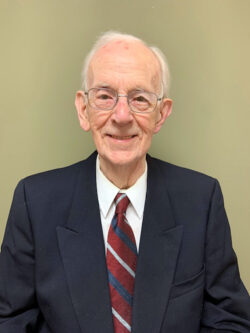Retired physiotherapist honoured for a lifetime of helping others
By Dale Woodard on May 29, 2021.
 David Giles was awarded a medal of distinction from the Canadian Physiotherapy Association.
David Giles was awarded a medal of distinction from the Canadian Physiotherapy Association.David Giles’ career has been a hands-on experience.
For that, the now-retired physiotherapist received a prestigious award.
Giles, who originally hails from England, was recently granted the medal of distinction from the Canadian Physiotherapy Association, celebrating his physiotherapy career that started in his native England back in 1951.
The medal recognizes over 100 individuals who have impacted physiotherapy from 1920 to 2020.
The distinction celebrates Giles’ vast career and arrival in Canada in 1966 and includes his book “A 12-Step Program Workbook”, published in June of 2003.
Reflecting on the age category of eligible award winners, the 89-year-old local resident joked about just meeting the age requirements.
“I first learned about a month ago,” said Giles. “I’m one of at least 100 people who have been honoured in this way. I was fascinated because it said ‘Those who have made a contribution to the physical therapy years in the last 100 years.’ I thought ‘I’m 89. I guess I just sort of squeezed in there.’ Yes, I feel I’ve made a contribution, but I’m sure I’m sure I’m one of the (older ones).”
Giles was born in England in 1932.
“I was raised in a very religious family and my father died unexpectedly when I was 17,” he said. “This meant I had to go and earn a living. I chose to become an apprentice student with the Institute of Hospital Administrators in England because I could earn while I learned. I was appointed through a large hospital in Leeds as an apprentice student.”
Giles became a chartered physical therapist from 1951 to 1954.
“I worked in England and had some interesting experiences in my first three or four appointments.”
When the Canadian government sent an immigration team over to England looking for people with various qualifications, Giles couldn’t pass up the opportunity, arriving in Calgary with his wife in April of 1966.
From there, Giles and his wife headed to Vancouver, where he got a job in the worker’s compensation board in the rehabilitation department for injured workers in Vancouver as a physical therapist.
Working in Vancouver in the early 1970s, Giles discovered the work of Frederick Mitchell and in 1975 resolved to be a 100 per cent hands-on practitioner, using no modalities.
In 1981, Giles and his family headed back west to where they arrived in 1966.
“We moved to Alberta, which was not involved at that time in anything dramatically new,” he said. “The only difference was there was no medical plan. When I came here, I had to work for a hospital or work for myself. I took a chance on private practice because I had been involved in that in my later years in Vancouver. I set up a practice and took it from there.”
Beginning his work in 1981 as a hands-on practitioner, a few of Giles’ physician colleagues explained to him that modalities were essential in Alberta if he wanted referrals. Giles bought $12,000 worth of equipment, but continued working with his hands.
“I developed my way of doing things with chronic pain,” said Giles. “I said to people ‘If you have been everywhere and tried everything and you can’t get help, come to me and I’ll see what I can do for you. But if you come to me I don’t want you to come for two or three more visits because if we’re not making any progress in two or three visits, I’m probably not going to be able to help you.’ When somebody would come once and I would tell them to go for a few days and then come back and tell me how they were, I used to dread it when they said ‘About the same.'”
However, a number of patients indicated to Giles they felt quite a bit better.
“So we did it four or five times and that was enough,” he said.
So 18-years ago next month, Giles put together “A 12-Step Program Workbook” to simply get the word out to his colleagues and use as they saw fit.
“I wrote it down in the form of a workbook and I gave it away. I didn’t sell it. It was free, no copyright, and if you can benefit your people, go for it,” he said. “It was only 40 pages. I put it on the computer and sent it around to various colleges and practitioners who I knew were interested.”
“A 12-Step Program Workbook” was divided up into a 12-step routine consisting of hips, lumbar spine, sacrum, ilia, psoas and tensor fascia lata, low thoracic, mid thoracic, cervico thoracic junction, sterno clavicular joint, cervical spine, atlanto occipital joint and connective tissue.
“Some people reported they were having quite good success,” said Giles. “I think that’s what brought it to attention. I was a mentor for a number of people and that’s what made my manual stick out a bit.”
In a world of social media and ongoing global events, Giles felt mental healing will now be coming to the forefront.
“Healing of mental illness, which we are causing ourselves, is what we need to look at next. I think that’s where it’s going.”
Follow @dwoodardherald on Twitter
3-2




